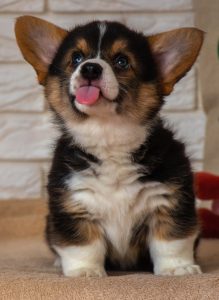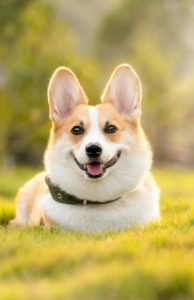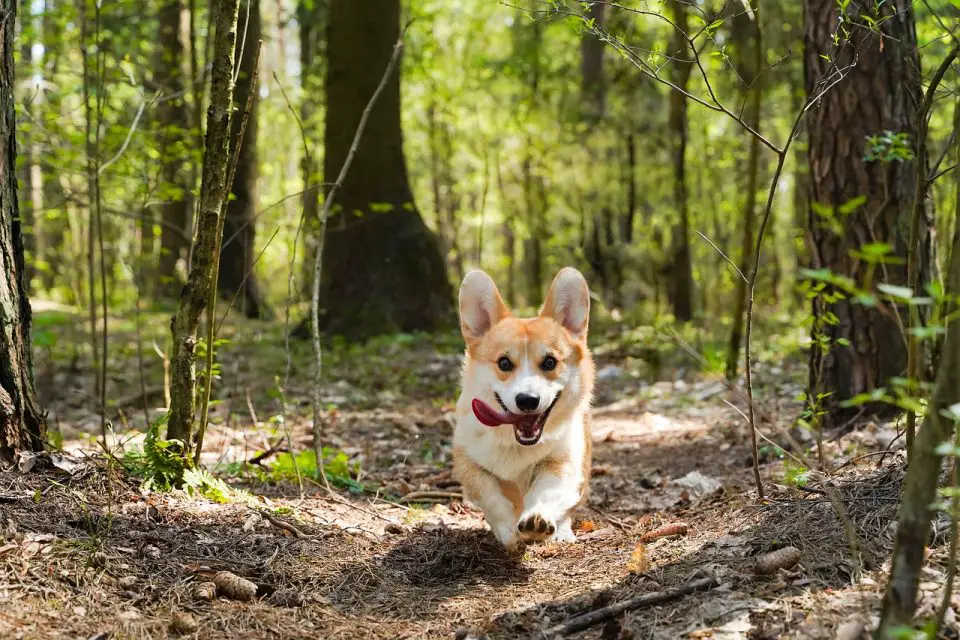A Little About Corgis
The name Corgi applies to two breeds of the dog namely the Pembroke Welsh Corgi and the Cardigan Welsh Corgi.
The Corgi is a cattle herding dog which was first bred in Pembrokeshire, Wales. Both dogs are thought to be descendants of the Siberian Husky breed.
Another theory states that Welsh Corgis came from Swedish Vallhunds which were bred with a local breed of herders.
Probably the most famous Corgis are those that belong to the Queen of England, Queen Elizabeth II.
Her Majesty has owned over 30 Corgis during her reign, and they have remained popular with royals for some 70 years.
Corgis are also popular in the USA with several cities such as Los Angeles and Boston holding annual ‘Corgi Meetups’ where owners can mix with other owners of the breed.
In Stanley Coren’s The Intelligence of Dogs, the Corgi ranked as number 11, where we read that the breed is considered to be an ‘excellent working dog.’
The American Kennel Club (AKC) rated the Corgi as 15th most popular breed in 2017.
Do Corgis Shed?
| Do Corgis Shed? In short, Yes Corgis do shed. The two corgi breeds have similar coats, in that they are both endowed with a thick undercoat and a fluffy over coat. The undercoat keeps them warm. Because there are two coats they will shed, and they will need grooming 2-3 times each week. |
As the temperatures start to rise, the dogs will start to shed the excess fur as it is no longer needed to keep them warm.
Considering that the dogs are relatively small, you will be sweeping up a huge amount of hair!
For this reason, most Corgi owners brush their pooches daily to keep the coat manageable and the house free from hair.
Both breeds will normally only need a bath every two or three months. They should not be bathed more than every 6 weeks as frequent baths damage the skin and natural oils.
Both dogs shed more as the seasons change although the Cardigan may shed slightly less.
Short History of the Corgi
The line of the Pembrokeshire Welsh Corgi can be traced back to 1107 where we read that Flemish weavers brought the dogs with them as they travelled to Wales to start their new lives.
A sweet ancient lore tells of two children who were running through a forest and came upon a fairy funeral.
The children were given two Corgi pups by the mourning fairies. The children brought the pups home with them, bred them, and the breed began.
Whether you believe this – and in fairies – is up to you, but it makes for a cute story.
Both Pembrokshire and Cardigan Welsh Corgis first appeared in 1925 when they were first shown at the Kennel Club of Great Britain. The Corgi Club was founded later that year in Carmarthen.
It seems that local members of the club favored the Pembroke breed, so the Cardigan Corgi fans opened one of their own a year later.
Both clubs have strived to ensure that the appearance and type of breed are standardized by a program of careful and selective breeding.
Both the Pembrokeshire and the Cardigan Corgis were officially welcomed into the Kennel Club in 1928 although they were placed under a single grouping of Welsh Corgis.
In 1934 the breeds were recognized as separate and distinct.
As of 2015 Pembroke Corgis ranked 20th in the AKC. These days the breed is registered as ‘vulnerable’ in the UK as there has been a decline in the popularity in that country.
The reason for the decline in UK popularity is thought to be because of the 2007 ban on docking the tails as well as to a lack of UK breeders.
What is a Corgis Coat Like?
The Cardigan Welsh Corgi has a wiry, medium-length coat which is easy to brush. It is also water resistant. They will shed twice per year. They have an undercoat but shed less than the Pembroke.
The Pembroke Corgi has a double coat, with a thick undercoat and a longer overcoat. This breed sheds continuously with a heavy shedding season at least twice through the year.
Pembrokes come in colors such as sable, red, fawn and tricolors, while Cardigan corgis can be found in more bicolor such as sable and white, red and white, brindle and white and black and white.

Why do Dogs Shed?
In dogs, shedding is a normal and healthy process which happens through the year with sometimes more hair than others.
Depending on the size, breed age and health condition, a dog may shed more or less than other breeds.
For many breeds, the hair is shed to get rid of dead hair and to start the growth of new hair with shedding being a natural way to keep the skin and hair in good shape.
Most dogs will shed a little more during spring and autumn as this is when the thick winter coat is discarded, and the spring coat comes in to keep them cooler in summer.
Some breeds shed more than others, while there are some breeds that shed hardly at all. Welsh Corgis fall into the category of heavy shedders.
How Much do Corgis Shed?
The Corgi fur grows randomly all over the body which results in random shedding. This means that no matter what the season, the dog will always have a double coat and will always shed.
Any breed with a double coat tends to shed more than a single coat breed. They will also shed constantly through the year and not just in the shedding season.
When Corgis were still herding sheep the warm undercoat kept them warm in the winter, while he stayed cool in the summer months. It meant, of course, that the dogs shed a lot.
Do Corgis Shed a lot?
Both Pembrokshire and Cardigan Welsh Corgis shed – a lot! They are classed as heavy shedders and you can expect to find hair on your floor every single day, even with vacuuming it up.
The double layered coat sheds out every day, and more in the shedding season. Never a day will go by when you do not see fur somewhere in the house.
When do Corgis Shed the Most?
The natural growth cycle of the Corgi coat makes it adapt to the different seasons.
During the winter months both coats are important to keep the dog warm and dry. This happens because the coat is both water resistant and has an insulating effect.
As spring approaches there is no need for the warm thick winter coat, so the shedding cycle starts with the dense undercoat falling out – all over the place!
At the end of the summer when the temperatures start to fall, the winter coat starts to grow, pushing out the summer hair to make way for dense lush under coats.
The cycle continues much the same although you can expect your Corgi to shed throughout the year, just not as much as during the seasons.
How to Combat Corgis Shedding
As a Corgi owner you will simply need to accept that your dog must be brushed every day.
This will reduce the amount of hair that is shed and flies around your house and you will – to a degree – be able to control the amount of hair on your furniture and floor.
Daily brushing with the correct brush will remove all the dead hair which gathers under the topcoat.
You may also want to schedule your brushing times so that you do it outside instead of in the house. Again, this will reduce the amount of hair on your floor.
When you brush your pooch, make sure that you only brush in the direction of the hair growth.

This may take you a little time to get used to as the Corgi coat often tends to grow in random directions across the body.
Brushing the hair in an outward direction will release the dead hair from the undercoat and it will easily come off on the brush.
Because brushing is such an essential part of the Corgi grooming, it is important that you start brushing at a young age, no matter how little your pup sheds.
They need to get used to being brushed regularly and all over their body.
Bathing may help – a little. Although it is not recommended that you bath your Corgi often, a bath with mild shampoo will help to loosen the dead hair.
Brush your dog before you bath him, and again after he has been dried.
Equipment Help to Combat Corgis Shedding
There are several items which you should include in your grooming basket, which will help to keep your pooch relatively hair free.
Rakes
These look similar to what we would use in the garden, just a lot smaller. Rakes are designed for the thick undercoat. The tines work below the topcoat to loosen the dead hair underneath.
This is a great way to loosen the dead hair, although you should be careful using this as the tines can irritate the skin if used too vigorously.
Ideally, with a rake, the tine should be the same length as your dog’s hair so that you do not scratch the skin.
Slicker brushes
These are designed to work with the topcoat. Normally the bristles are stiffer, and they work all the way through the top and down to the bottom coat to remove unwanted hair.
Typically, the bristles are metal and slightly curved to release the dead hair and bring it to the top.
Bristle brushes
These brushes mostly deal with the topcoat as they may not be strong enough to get all the way down to the base.
Bristle brushes work best when you have bathed your pooch and want to give him a final brush to remove any excess hair.
These brushes work well at giving the coat a shiny look as they redistribute the natural oils over the surface.
Grooming gloves
While these may not get right through the dense hair of the Corgi, they will remove some unwanted hair.
They also give you a chance to spend more time with your pooch and make them comfortable with brushing.
If you are going to use a glove, it is best used in conjunction with a de-shedding tool.
Are Corgis considered to be hypoallergenic?
In truth, there is no such thing as a hypoallergenic dog as all dogs shed to some degree.
The Corgi, however, sheds a lot and is definitely not a hypoallergenic breed. Because dogs release dander every time they drop hairs, this may not be the best breed if you suffer from allergies.
Do Some Corgis Shed More Than Others?
When it comes to shedding, there is very little difference between a Pembrokeshire Welsh Corgi and a Cardigan Welsh Corgi. Both breeds shed about the same amount.
Both breeds shed seasonally during the year and also constantly during the year, and both will leave you with a pile of hair after you have groomed them.
Health Reasons for Increased Shedding in Corgis
If your Corgi sheds more than normal, you may first want to look at the diet. Corgis who do not receive a dog food that contains all the vital nutrients will shed even more – if that is possible!
Corgis that are well fed have shiny smooth coats, while those lacking in good diets will manifest it by shedding more.
Poor grooming is another reason for extra shedding. For this reason, you need to get your pup used to being handled and brushed form an early age.
A quick brush every day will simply not be enough to keep shedding under control.
A change in hormones will have your pooch shedding more. Females who are in season, pregnant or lactating will shed more. This will return to normal when the pups are weaned.
Corgis do not like stress and will show that they are unhappy by shedding more. They do not like change to their routine so keeping things as calm and ‘normal’ as possible will means slightly less shedding.
Final Thoughts: Do Corgis Shed?
 If you can adapt yourself and your home to the hair, and how to get rid of it, or at least keep it under control, there is no reason why you should not have a Corgi as your companion.
If you can adapt yourself and your home to the hair, and how to get rid of it, or at least keep it under control, there is no reason why you should not have a Corgi as your companion.
They are lovely dogs, make great companions and get on well with most people.
Unfortunately, the breed sheds – a lot, and this may be a deciding factor when choosing a new pup.
